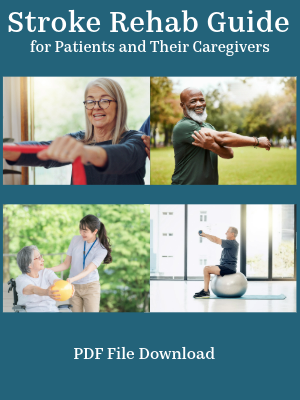Leg Exercises
Medically reviewed by Karen Murray, OT, CHT, CSRS - written by Stroke-rehab.com
Some leg exercises that can be done by stroke patients are demonstrated below. Exercises are shown in lying, sitting, and standing and can be adapted to the stroke patient's needs. Please check with your physician or therapist first to see if these exercises are appropriate for you or if they need to be adapted in anyway.
Discontinue any exercises that cause pain. The number of repetitions that can be done will depend on your strength and endurance. Do however many repetitions you can and work up to more as you get stronger. If you are able to do 20-30 repetitions without problem, ankle weights can be added to increase resistance.
 |
 |
Hip Abduction/Adduction
Lying on your back, slide the affected leg out to the side and back in.
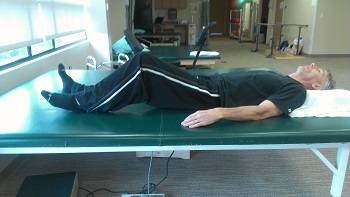 |
 |
Heel Slides
Lying on your back, slide the affected foot up toward your buttocks, bending your knee and then slide back down until the knee is straight.
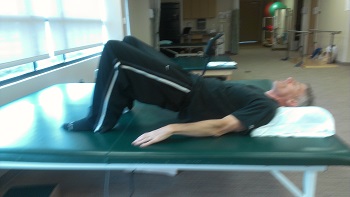
Bridging
Lying on your back with your knees bent and feet on the bed or mat, lift your hips up toward the ceiling and back down.
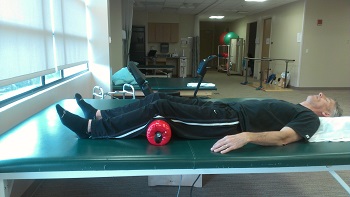 |
 |
Lying Terminal Knee Extension
Lying on your back, place a bolster (several rolls of towel can be used) behind your knees. Lift your affected foot off the mat or bed straightening the knee and then lower your foot back down.
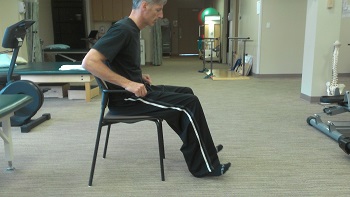
Toe and Heel Raises
Sitting in a chair, raise your toes up and down then raise your heels up and down (heel lifts not shown).
 |
 |
Foot/Ankle Circles
Sitting in a chair, hold your foot up and circle it around in one direction for ten repetitions and then switch and circle it in the other direction.
 |
 |
Sitting Knee Extension
Sitting in a chair, slowly kick the affected leg straight out and back down.
 |
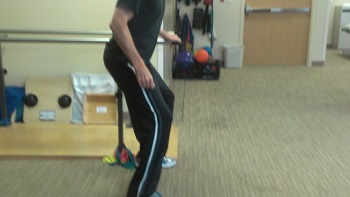 |
Squats
Holding to a stable surface, partially bend the knees as if sitting back on a chair and then stand back up straight.
 |
 |
Standing Knee Extension
Holding on to a stable surface, bend and straighten the affected leg as if kicking.

Hamstring Curl
Holding to a stable surface, try to bring the heel of the affected leg toward the buttocks and back down.
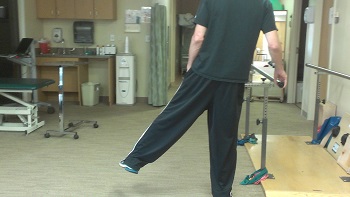
Hip Abduction in Standing
Holding to a stable surface, lift the affected leg out to the side and back down.

Hip Extension in Standing
Holding to a stable surface, raise the affected leg backwards and back down (attempting to keep the knee straight)
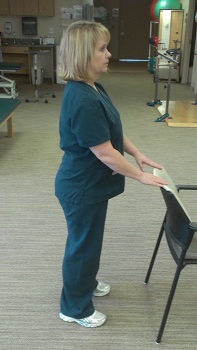 |
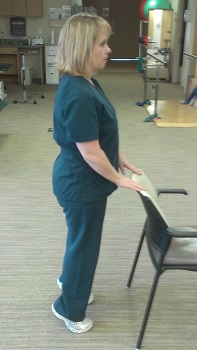 |
Toe Raises in Standing
Holding on to a stable surface raise up on the toes and back down.
One other exercise that can be done that is not shown above is to sit in a chair and place a ball between the knees. Squeeze the ball as if bringing the knees together. There are many more leg exercises that can be done, but these will provide a good start for the stroke patient. Remember that ankle weights can be added to make the exercises more difficult and to add resistance.
- Home
- Leg Exercises
Get Our Stroke Rehab Guide

Our stroke rehab guide is designed specifically for patients and caregivers. It's in pdf format and can be immediately downloaded. It includes about
- Stroke Definition & Causes
- Stroke Treatment
- Rehabilitation Information for Physical, Occupational and Speech Therapy
- Exercise pictures
- Q&A from patients and caregivers
- Adaptive Equipment & Techniques
- How to Prevent Another Stroke & More!
Medical Disclaimer: All information on this website is for informational purposes only. This website does not provide medical advice or treatment. Always seek the advice of your physician or other healthcare provider before undertaking a new healthcare or exercise regimen. Never disregard professional medical advice or delay seeking medical treatment because of something you have read on this website. See the disclaimer page for full information.
- Home
- Leg Exercises
